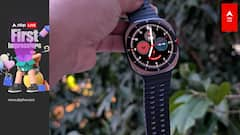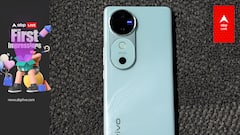Wearing It Well: Indian Wearables Market Surges Ahead In H1 2022, Reveals IDC
As per IDC, this growth has been spurred by brands lowering price points.

The Indian smartphone market and the country’s overall economy itself might be going through a slightly rough patch, but wearables are doing very well indeed. According to a report by research outfit IDC's India Monthly Device Tracker, wearables in India grew by a staggering 113 percent year on year in the second quarter of 2022 (Q2 2022). The report, which covers wristbands, watches, and earphones, also revealed how Indian brands continue to rule the roost in the wearable market and how OnePlus, a brand normally associated with phones, is a rising force in the segment. Here are some of the highlights and trends that we spotted in the report:
Spectacular growth in the segment
The wearables segment registered a very impressive growth not just in Q2 2022, but also in the entire first half of the year. A total of 23.9 million wearable devices were shipped in Q2 2022, which represented a stupendous 113 percent growth as compared to this period last year (Q2 2021). The period from January to June this year saw 38 million wearables shipped, which was 65.8 percent more than in the first half of 2021.
Interestingly, this growth has come at a time when the smartphone market, which provides the foundation for many wearables, has actually been witnessing a bit of a slowdown. All the top five brands in the segment recorded impressive rates of growth — the slowest growing brand grew at 76.6 percent.
What's even more fascinating is that the top five in the Indian wearables market mainly comprise three Indian brands Boat, Noise, and Fire-Boltt, that account for more than half of the wearables shipped in the market.
Growth powered by price cuts?
According to an IDC India executive, this growth has been spurred by brands lowering price points, with features that were earlier seen at higher price points such as larger screens and AMOLED displays now being available at much lower prices. This evidently has attracted both first-time users and upgraders.
As per IDC, a key reason for the growth in wearables is the fact that their prices have been coming down, as affordability is a "key growth lever." The overall average selling price of wearables declined by 7.2 percent in Q2 2022, as per IDC. That might not seem like a huge decline — a wearable priced at Rs 5,000 would now be available for about Rs 4,640, or at the budget end, a Rs 1,000 wearable would be available for Rs 928, which is not a massive dip.
However, this is just the overall average — some sectors (basic watches for instance), witnessed a very steep fall in prices, which made a huge impact, though. It is interesting to see prices dip in the wearables segment even as many smartphone prices go up, citing increased prices of components.
Most wearables are hearables
Hearables, which IDC defines as wearables that hang on or plug into the ear, are wireless, provide stereo sound, and have at least one smart feature (ANC, virtual assistant, translation, fitness tracking), make up the vast majority of the wearables in the Indian market.
The second quarter of 2022 saw hearables account for as much as 72.6 percent of all wearable shipments. About 17.3 million hearables were shipped, representing a growth of 87.6 percent.
The TWS era is here
The growth in hearables was driven by an incredible growth in the use of true wireless stereo (TWS) earbuds. In the second quarter, TWS accounted for about half of all hearable shipments and recorded a growth of 187.4 percent year on year. They might have their issues, but the totally wireless earbuds are market favorites in India.
Watch out! The smartwatches are driving growth
As per IDC, watch-based wearables were the fastest growing in wearables. A total of 6.4 million watch-based wearables were shipped in Q2 2022. That is a staggering 298.4 percent more than in 2021, seeing an almost threefold growth. A key reason for this growth was a dramatic drop in their prices — the average selling price of watch-based wearables fell by 28.9 percent and was at $45.1 (roughly Rs 3,600).
Basic watches are way more popular than smartwatches
IDC has divided the watch-based category into two segments: smartwatches like the AppleWatch and WearOS watches, basically watches with a proper OS and the option to install and run apps, as well as basic watches, which have some smart functionalities (like watches from Noise and Boat, according to IDC).
Of these two, it is the basic watches that have been bossing the Indian market, with a 92.5 percent share, reflecting growth of 306.4 percent in Q2 2022. When it comes to wrist-based wearables, price is clearly a major driving force in the Indian market.
Samsung, interestingly, was the sole smartwatch brand in the top five of the watch-based category, with a 3 percent market share.
Fitness bands fade out
Ironically, wristbands (fitness bands), which can be said to have pioneered the whole wearable revolution in 2015, are on the way out. Their shipments declined by 63 percent as compared to this time last year.
It is notable that this dip in wristband shipments comes even as the prices of watch-based wearables come down. The average selling price of a watch-based wearable, as per IDC, in Q2 2022 was about Rs 3,600, which is close to the price of many wristbands.
Boat sails well ahead of the competition
Imagine Marketing (which makes Boat) was the runaway leader in the wearables market in India, accounting for more than a third of all wearable shipments in the quarter, with a share of 34.3 percent, recording a growth of 76.8 percent.
It was the dominant player in TWS, with a 42.8 percent share, and ranked third in watch-based wearables with a 19.7 percent share. In fact, Imagine Marketing's share of the wearables market was more than the next four players taken together, which gives one an idea of the level of its domination.
In sheer terms of market share, however, its share dipped from 41.3 percent in Q2 2021, although it recorded a very impressive growth of 76.6 percent year on year.
The Noise behind Boat is growing
The four brands behind Boat are placed much more closely together. Nexxbase (which is behind Noise) accounted for an 11.5 percent share, growing by a very impressive 256.5 percent year on year, and continued to remain the leader in watch-based wearables with a share of 28.5 percent (a growth of almost 300 percent).
It was also second in the TWS segment behind Boat. It remains well behind Boat but increased its market share from 6.9 percent in Q2 2021 to 11.5 percent.
OnePlus goes 'hear, hear'
OnePlus, however, was the surprise of the quarter, taking the third spot in the wearables with a year-on-year growth of 129.7 percent, and a market share of 8.7 percent. Quite amazingly, it recorded this growth mainly through hearables, taking the second spot with an 11.9 percent share of the segment.
The brand also took fifth place in the TWS segment. Interestingly, OnePlus did so well without releasing a single watch or fitness band this year and carved a niche for itself in the hearables segment against extremely competitive offerings from the likes of Realme, Xiaomi, Jabra, Sony, and a few others. Audio is clearly emerging as a strong point for the Never Settling brand, although its foray into television has not worked out quite as well.
Thousand percent growth? That's Fire-Boltt
The most spectacular growth in the segment was recorded by the Indian brand Fire-Boltt. The brand took fourth place in the wearables market, expanding its share to 6.8 percent from a mere 1 percent, recording a mind-boggling growth of 1432.5 percent (you read that right). The brand did very well in the watch category, taking second place with a share of 24.8 percent, and also got into the TWS segment, which further boosted volumes.
Realme rounds off the top five
Realme has been very aggressive in terms of product launches in 2020, and its efforts got it a top-five slot in the wearables category. The brand's market share dipped to 4.6 percent from 5.2 percent a year ago but its shipments went up impressively, growing by 87.9 percent year on year.
As per IDC, this growth was driven mainly by two TWS products, the Buds Wireless Neo and TechLife Buds N100, which accounted for almost half (42.9 percent) of the brand's overall shipments.
It is interesting that even though four of the top five smartphone brands in the country — Samsung, Xiaomi, Oppo, and Realme — have significant wearable portfolios, Realme was the only one to make the top five in both the smartphone and wearable product segments in the country.
Growth could further accelerate in 2022
The outlook for wearables in India remains rosy for the rest of the year as well.
IDC says that wearable demand has now moved beyond urban centres and is now making itself felt in smaller cities and towns, driven by aggressive marketing and pricing by key brands.
Interestingly, the category remains online heavy, so online sales further drive volumes. IDC has predicted shipments of more than 90 million wearables for 2022. Considering that the first half of 2022 has seen 38 million wearables shipped, that means the remainder of the year could generate a further 52 million units. India is clearly wearing its wearables well.
Related Video
Apple creates a new record in iPhone sales after launch of iPhone 16 | ABP Paisa Live
Top Headlines





































